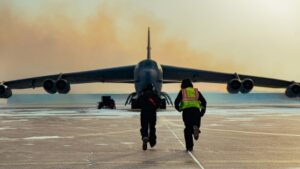Phase II of Pentagon Study Might Provide Some Answers

Crew chiefs assigned to the 23rd Aircraft Maintenance Squadron run toward a 23rd Bomb Squadron B-52H Stratofortress at Minot Air Force Base, N.D., in February. Concerns have been raised about higher cancer rates in pilots, as well as aircrew. U.S. Air Force photo by Staff Sgt. Michael A. Richmond
WASHINGTON, DC — Military aviators and the ground crews that service their planes are at a greater risk to develop melanoma and other types of cancer, according to a Pentagon study released last month. Just what factors are contributing to that risk remains unknown, however.
The study found that aircrew had an 87% higher rate of melanoma than the civilian population, as well as a higher rate of thyroid cancer (37%), prostate cancer (16%) and a higher rate of cancer of all sites (24%). Ground crew members demonstrated higher incidence of cancer of the brain and nervous system (9%), thyroid (15%), melanoma (9%), kidney and renal pelvis (9%), as well as a higher rate of cancer of all sites (3%).
While previous studies have demonstrated the higher risk for melanoma and prostate cancer among aircrew, this is the first time some other types of cancer, such as thyroid cancer, have been detected. This is also the first time increased rates were seen among ground crew—a population for which few studies have been published.
The study came out of the National Defense Authorization Act of 2021, which required DoD to investigate the incidence of cancer diagnosis and mortality in military aviators and aviation support personnel. The study’s inclusion in the yearly defense spending bill was urged by veterans’ service organizations, which for years have recognized a higher rate of cancer diagnoses among military aircrew.
In Phase 1 of the study, DoD researchers pooled data on 156,050 aircrews and 737,891 ground crew that had served between 1992 and 2017, making this the largest study of its kind. Previous studies have included health records going back to the 1970s; however, standardized personnel data were not available for all service branches until the 1990s.
While the study found that military airmen were more likely to develop cancer, they were not less likely to die from it. Mortality rates among both air and ground crew were found to be either similar or lower than the general population.
Investigators speculated on the reasons for this, including suggesting it could be credited to the “healthy-soldier effect.” Not only are members of the military more physically fit than the general population, they have better access to medical care. Aircrew especially may be required to meet even more stringent physical standards to maintain their flight status. Therefore, cancer may be more likely to be detected and treated early.
The low mortality rates also could be a factor of the study’s limitations, which the investigators stressed in their report.
There are large gaps in military cancer case data, including no complete data on cancer diagnoses prior to 1990. Other studies have found that the healthy soldier effect can erode over time, and that retired servicemembers will eventually fall back to general population fitness levels. The researchers speculated that, if older servicemembers and veterans had been included in the study, the cancer mortality rate could have been higher.
DoD will take another look at the numbers after pooling in VA’s Central Cancer Registry, as well as the Virtual Pooled Registry Cancer Linkage System. According to investigators, this will give them a better understanding of cancer cases for Reserve, National Guard and servicemembers without TRICARE coverage.
What is causing this increased rate of cancer diagnosis is the focus of Phase 2 of the study. Melanoma has long been known to be a risk for aircrew. A 2015 study of civilian aircrew found twice the risk for melanoma than the general population, which researchers blamed at least partly on increased altitude-related exposure to UV and cosmic radiation.
That increased melanoma was also seen in military ground crew suggests there might be other risk factors, however. And the wide variety of cancers seen in both air and ground crew might point to other environmental hazards.
In this next phase, researchers will begin identifying the carcinogenic toxins and hazardous materials associated with military flight operations; identifying operating environments that could be associated with increased amounts of radiation; identifying specific duties, dates of service and types of aircraft flown that could have increased the risk for cancer. They’ll also be looking at service-related exposures not related to aviation.
Phase 2 will also involve determining the appropriate age to begin screening military air and ground crew for cancers.
